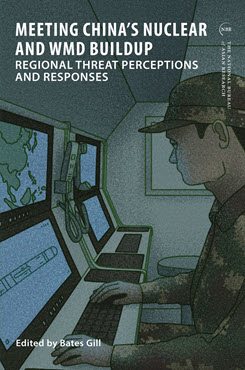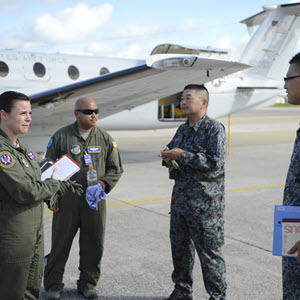NBR Special Report No. 109
Meeting China's Nuclear and WMD Buildup
Regional Threat Perceptions and Responses
This NBR Special Report presents case studies of how six regional countries (Australia, India, Japan, the Philippines, Taiwan, and Vietnam) view China’s development of its nuclear weapons and other WMD capabilities. The case studies are preceded by an introduction from editor Bates Gill that discusses key findings and policy implications.
Australia and Chinese Nuclear Modernization: Waking Up to New Nuclear Realities
China’s Nuclear Modernization and Taiwanese National Defense: Flexibility, Resilience, and Deterrence
India’s Changing Attitude toward Nuclear Expansion
China’s Nuclear Modernization and Its Implications for Japan
Will the Pathogen Spread South? The Implications of a Chinese Biological Weapons Program for Vietnam
A Philippine Perspective on China’s WMD Threat
Introduction: Meeting the Challenge of China’s WMD Buildup
Bates Gill
Stating that the People’s Republic of China (PRC, or China) is “America’s most consequential geopolitical challenge” and “most consequential strategic competitor for the coming decades,” the 2022 U.S. National Security Strategy (NSS) and U.S. National Defense Strategy (NDS) made clear that deterring aggression by the PRC is a vital interest of the United States.[1] According to the NDS, China seeks to “refashion the Indo-Pacific region and the international system to suit its interests and authoritarian preferences” and aims to “undermine U.S. alliances and security partnerships in the Indo-Pacific region, and leverage its growing capabilities, including its economic influence and the People’s Liberation Army’s (PLA) growing strength and military footprint, to coerce its neighbors and threaten their interests.”[2] Based on this assessment, the NSS finds that the United States’ “defense strategy must sustain and strengthen deterrence, with the PRC as our pacing challenge.”[3]
China’s ongoing military buildup undoubtedly presents complicated and worrisome challenges for the United States and its armed forces, especially in the Indo-Pacific. Of particular concern in recent years—and the subject of this report—China’s investments in its nuclear arsenal and possibly other WMD-related technologies pose new and vexing questions about U.S. deterrence strategies, extended deterrence commitments, conventional capabilities, and maintaining solidarity with regional treaty allies and other partners.
On the positive side, the United States is not alone in facing these challenges and shares many of the same security concerns with others in the region. Importantly, countries across the Indo-Pacific—including U.S. allies and security partners such as Australia, India, Japan, the Republic of Korea, the Philippines, Taiwan, and Vietnam—can agree in principle on the need to confront China’s increasing coercive, deterrent, and warfighting capabilities. On the other hand, however, it is difficult in practice to introduce more effective collaborative measures, bilaterally and particularly multilaterally, that can deflect and deter the most threatening elements of the PRC’s military buildup. As a result, the United States—working with regional allies and partners—needs to build not only a deeper shared awareness of the security threats China presents but also a stronger regional consensus on how countries can cooperate with one another to counter them.
To help advance this aim, the National Bureau of Asian Research (NBR), with support from the Defense Threat Reduction Agency (DTRA) Strategic Trends Research Initiative, in 2020 initiated an innovative Track 1.5 research and strategic dialogue project under the title “Meeting China’s Military Challenge: Identifying Collective Responses among U.S. Allies and Security Partners in the Indo-Pacific Region.” Through commissioned research and dialogue activities, the project engaged experts and government officials from a mix of regional allies and security partners with differing security environments, military capabilities, and relations with China, with a focus on Australia, India, Japan, the Philippines, Taiwan, and Vietnam.
In year one, the project delivered in-depth research, dialogue, and analysis regarding China’s most threatening conventional deterrent, coercive, and warfighting capabilities; their effect on U.S. allies and security partners; and policy options for these governments to partner with the United States to effectively counter these challenges. This work was presented in an NBR Special Report released in early 2022.[4]
In its second year, the project brought together senior experts and government officials from the United States and the same six Indo-Pacific countries—Australia, India, Japan, the Philippines, Taiwan, and Vietnam—to focus on China’s advanced conventional technologies, including cyber, space, and autonomous weapons systems. The expert discussions in this phase considered specific scenarios in which the PRC has employed and likely will employ these capabilities against U.S. allies and security partners in the region; the military policies and operational capabilities that have been employed in response by U.S. allies and security partners in the region; and specific mechanisms that should be considered for Indo-Pacific governments, in partnership with the United States or among themselves, to counter these PRC threats. The findings were published in an NBR Special Report in late 2022.[5]
In year three, the project focused on China’s nuclear weapons and other WMD capabilities by addressing the following key questions:
- What specific PRC nuclear or other WMD-related systems present the most credible deterrent, coercive, and warfighting threats?
- In addition to potential direct threats from PRC nuclear or other WMD-related systems, what indirect threats arise from these systems?
- What specific scenarios are likely for the PRC’s use of nuclear and other WMD-related deterrent, coercive, and warfighting threats?
- What specific military policies and operational capabilities have been employed in response?
- What specific mechanisms could the United States and its regional partners employ to effectively counter these PRC nuclear or other WMD-related threats?
To address these questions, and following the model of the previous two years, the project combined commissioned research papers and strategic dialogue exchanges to engage experts and government officials from the United States alongside those from the six Indo-Pacific countries noted above. The commissioned research was repeatedly interrogated and sharpened through constructive feedback and criticism over the course of the project. This feedback was provided by NBR project leads and DTRA project sponsors, as well as by outside experts and government officials taking part in a virtual workshop held in March 2023 and an in-person, two-day Track 1.5 strategic dialogue in Washington, D.C., in June 2023, where the commissioned research papers served to frame and catalyze discussions. Coming out of this process, this introduction presents the project’s findings and policy implications, followed by the detailed commissioned studies by the six country experts involved in this iteration of the project.
On behalf of NBR, I wish to convey many thanks and great appreciation to the following individuals whose insights and expertise drove the project’s discussions, shaped its findings and policy implications, and ensured its success: Herman Joseph S. Kraft of the University of the Philippines Diliman, Lavina Lee of Macquarie University, Wakana Mukai of Asia University, Rajeswari Pillai Rajagopalan of the Observer Research Foundation, Jyh-Shyang Sheu of the Institute for National Defense and Security Research, and Khang X. Vu of Boston College.
The following pages of this introductory essay summarize the project’s year-three findings under six principal themes that arose from the commissioned research, workshop discussions, and strategic dialogue sessions. This essay will also present a detailed set of actionable policy options for the United States that flow from the project’s research, analysis, and key findings. Readers seeking more detailed country-by-country analysis and policy implications are encouraged to delve into the specific country studies—on Australia, India, Japan, the Philippines, Taiwan, and Vietnam—that make up the remainder of this study.
Download the report to read the rest of this introductory essay.
Bates Gill is Senior Fellow for Asian Security with the National Bureau of Asian Research (NBR). He is the principal investigator for the NBR project “Meeting China’s Military Challenge: Identifying Collective Responses among U.S. Allies and Security Partners in the Indo-Pacific Region.”
Endnotes
[1] White House, National Security Strategy (Washington, D.C., October 2022), 11, https://www.whitehouse.gov/wp-content/uploads/2022/10/Biden-Harris-Administrations-National-Security-Strategy-10.2022.pdf; and U.S. Department of Defense, National Defense Strategy of the United States of America (Washington, D.C., October 2022), iii, https://media.defense.gov/2022/Oct/27/2003103845/-1/-1/1/2022-NATIONAL-DEFENSE-STRATEGY-NPR-MDR.PDF.
[2] U.S. Department of Defense, National Defense Strategy of the United States of America, 4.
[3] White House, National Security Strategy, 22.
[4] Bates Gill, ed., “Meeting China’s Military Challenge: Collective Responses of U.S. Allies and Security Partners,” National Bureau of Asian Research, NBR Special Report, no. 96, January 2022, https://www.nbr.org/publication/meeting-chinas-military-challenge-collective-responses-of-u-s-allies-and-partners.
[5] Bates Gill, ed., “Meeting China’s Emerging Capabilities: Countering Advances in Cyber, Space, and Autonomous Systems,” NBR, NBR Special Report, no. 103, December 2022, https://www.nbr.org/publication/meeting-chinas-emerging-capabilities-countering-advances-in-cyber-space-and-autonomous-systems.



